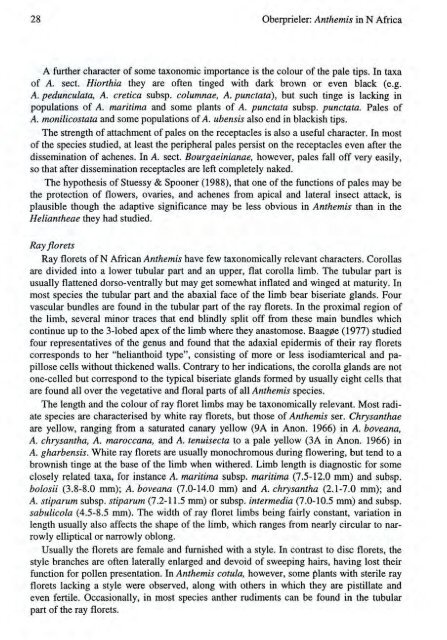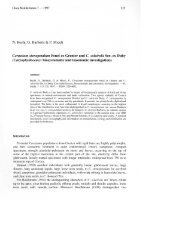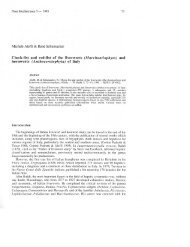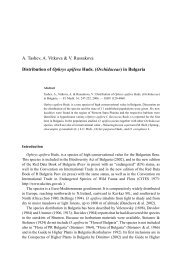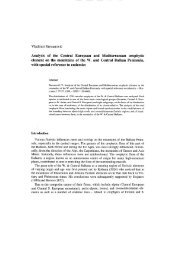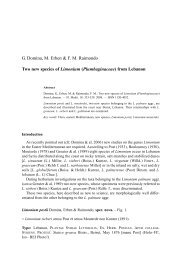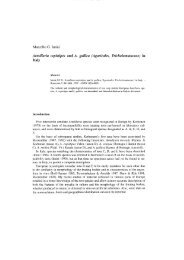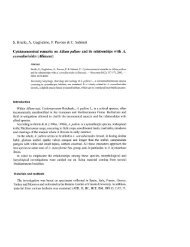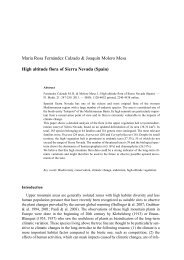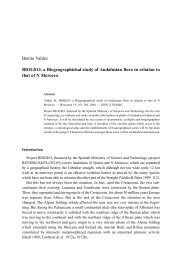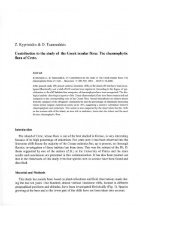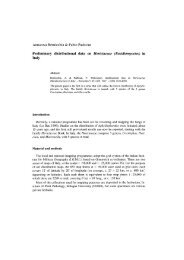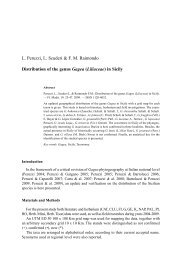Christoph Oberprieler The Systematics of Anthemis L. - Herbmedit.org
Christoph Oberprieler The Systematics of Anthemis L. - Herbmedit.org
Christoph Oberprieler The Systematics of Anthemis L. - Herbmedit.org
You also want an ePaper? Increase the reach of your titles
YUMPU automatically turns print PDFs into web optimized ePapers that Google loves.
28 <strong>Oberprieler</strong>: <strong>Anthemis</strong> in N Africa<br />
A further character <strong>of</strong> some taxonomic importance is the colour <strong>of</strong> the pale tips. In taxa<br />
<strong>of</strong> A. sect. Hiorthia they are <strong>of</strong>ten tinged with dark brown or even black (e.g.<br />
A. pedunculata, A. eretica subsp. columnae, A. punctata), but such tinge is lacking in<br />
populations <strong>of</strong> A. maritima and some plants <strong>of</strong> A. punctata subsp. punctata. Pales <strong>of</strong><br />
A. monilicostata and some populations <strong>of</strong> A. ubensis also end in blackish tips.<br />
<strong>The</strong> strength <strong>of</strong> attachment <strong>of</strong> pales on the receptacles is also a useful character. In most<br />
<strong>of</strong> the species studied, at least the peripheral pales persist on the receptacles even after the<br />
dissemination <strong>of</strong> achenes. In A. sect. Bourgaeinianae, however, pales fall <strong>of</strong>f very easily,<br />
so that after dissemination receptacles are left completely naked.<br />
<strong>The</strong> hypothesis <strong>of</strong> Stuessy & Spooner (1988), that one <strong>of</strong> the functions <strong>of</strong> pales may be<br />
the protection <strong>of</strong> flowers, ovaries, and achenes from apical and lateral insect attack, is<br />
plausible though the adaptive significance may be less obvious in <strong>Anthemis</strong> than in the<br />
Heliantheae they had studied.<br />
Ray florets<br />
Ray florets <strong>of</strong> N African <strong>Anthemis</strong> have few taxonomically relevant characters. Corollas<br />
are divided into a lower tubular part and an upper, flat corolla limb. <strong>The</strong> tubular part is<br />
usually flattened dorso-ventrally but may get somewhat inflated and winged at maturity. In<br />
most species the tubular part and the abaxial face <strong>of</strong> the limb bear biseriate glands. Four<br />
vascular bundles are found in the tubular part <strong>of</strong> the ray florets. In the proximal region <strong>of</strong><br />
the limb, several minor traces that end blindly split <strong>of</strong>f from these main bundles which<br />
continue up to the 3-lobed apex <strong>of</strong> the limb where they anastomose. Baag0e (1977) studied<br />
four representatives <strong>of</strong> the genus and found that the adaxial epidermis <strong>of</strong> their ray florets<br />
corresponds to her "helianthoid type", consisting <strong>of</strong> more or less isodiamterical and papillose<br />
cells without thickened walls. Contrary to her indications, the corolla glands are not<br />
one-celled but correspond to the typical biseriate glands formed by usually eight cells that<br />
are found all over the vegetati ve and fiorai parts <strong>of</strong> all <strong>Anthemis</strong> species.<br />
<strong>The</strong> length and the colour <strong>of</strong> ray floret limbs may be taxonomically relevant. Most radiate<br />
species are characterised by white ray florets, but those <strong>of</strong> <strong>Anthemis</strong> ser. Chrysanthae<br />
are yellow, ranging from a saturated canary yellow (9A in Anon. 1966) in A. boveana,<br />
A. chrysantha, A. maroccana, and A. tenuisecta to a pale yellow (3A in Anon. 1966) in<br />
A. gharbensis. White ray florets are usually monochromous during flowering, but tend to a<br />
brownish tinge at the base <strong>of</strong> the limb when withered. Limb length is diagnostic for some<br />
closely related taxa, for instance A. maritima subsp. maritima (7.5-12.0 mm) and subsp.<br />
bolosii (3.8-8.0 mm); A. boveana (7.0-14.0 mm) and A. chrysantha (2.1-7.0 mm); and<br />
A. stipa rum subsp. stiparum (7.2-11.5 mm) or subsp. intermedia (7 .0-10.5 mm) and subsp.<br />
sabulicola (4.5-8.5 mm). <strong>The</strong> width <strong>of</strong> ray floret limbs being fairly constant, variation in<br />
length usually also affects the shape <strong>of</strong> the limb, which ranges from nearly circular to narrowly<br />
elliptical or narrowly oblong.<br />
Usually the florets are female and furnished with a style. In contrast to disc florets, the<br />
style branches are <strong>of</strong>ten laterally enlarged and devoid <strong>of</strong> sweeping hairs, having lost their<br />
function for pollen presentation. In <strong>Anthemis</strong> cotula, however, some plants with sterile ray<br />
florets lacking a style were observed, along with others in which they are pistillate and<br />
even fertile. Occasionally, in most species anther rudiments can be found in the tubular<br />
part <strong>of</strong> the ray florets.


